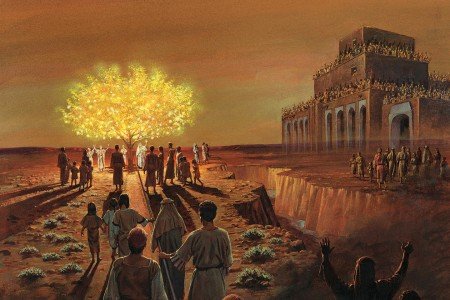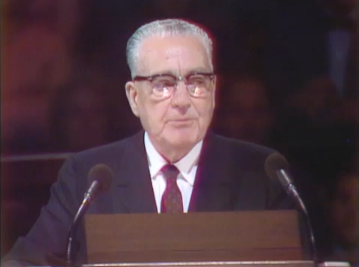In this week’s installment of our ongoing series reading sermons from past General Conferences of the Church of Jesus Christ of Latter-day Saints, we are looking at the Sunday Afternoon Session of the April 1971 conference. Posts by other bloggers on this session will be included at the end. A useful index of all of the posts by all of the bloggers in this series can be found here.
Among dissident members of the church, this particular session of conference is somewhat famous, or perhaps more accurately infamous. Or at least it ought to be. In 1967 Richard Poll, a BYU professor, published a talk he had given in sacrament meeting, in which he characterized members of the church as either “Iron Rod” members or “Liahona” members. The published talk is still quite popular in certain circles. I have seen it cited many times, even in the last decade.
For anyone who is not familiar with these terms, “Iron Rod” is derived from a metaphorical vision recounted in the Book of Mormon by the prophet Lehi, in which he saw an iron rod or handrail that guided people along a path through a dark and dangerous landscape to the tree of life, with pure and delicious fruit. The term “Liahona” is also from the Book of Mormon and is the name of a compass-like instrument that God provided to Lehi and his family to guide them as they traveled in the wilderness to a new land.
Brother Poll explained his taxonomy like this:
“The Iron Rod, as the hymn reminds us, was the Word of God. To the person with his hand on the rod, each step of the journey to the tree of life was plainly defined; he had only to hold on as he moved forward. In Lehi’s dream the way was not easy, but it was clear.
The Liahona, in contrast, was a compass. It pointed to the destination but did not fully mark the path; indeed, the clarity of its directions varied with the circumstances of the user. For Lehi’s family the sacred instrument was a reminder of their temporal and eternal goals, but it was no infallible delineator of their course.
Even as the Iron Rod and the Liahona were both approaches to the word of God and to the kingdom of God, so our two types of members seek the word and the kingdom. The fundamental difference between them lies in their concept of the relation of man to the ‘word of God.’ Put another way, it is a difference in the meaning assigned to the concept ‘the fullness of the Gospel.’ Do the revelations of our Heavenly Father give us a handrail to the kingdom, or a compass only?
The Iron Rod Saint does not look for questions, but for answers, and in the Gospel–as he understands it–he finds or is confident that he can find the answer to every important question. The Liahona Saint, on the other hand, is preoccupied with questions and skeptical of answers; he finds in the Gospel–as he understands it–answers to enough important questions so that he can function purposefully without answers to the rest.”
This Iron Rod vs Liahona characterization clearly appeals to those who find Brother Poll’s “Liahona Saint” applicable to their own views and a “liberal” approach to the gospel. That is why it has had such staying power for nearly 50 years. For many of those who cite his taxonomy approvingly, “Iron Rod” is used as a kind of pejorative, similar to the smug internet acronym TBM (True Blue Mormon) used to refer to faithful members who accept the authority and direction of the living prophets and apostles.
Almost four years later, in the Sunday Afternoon Session of the April 1971 conference, after Brother Poll had resigned from BYU (at least partially because of conflicts with the leaders of the church and the school), Harold B. Lee, who was at the time President of the Quorum of the Twelve Apostles of the Church, gave a sermon entitled “The Iron Rod” in which he reviewed at length the same vision of the iron rod and the tree of life and then alluded to and responded to Brother Poll’s talk (without attribution).
“If there is any one thing most needed in this time of tumult and frustration, when men and women and youth and young adults are desperately seeking for answers to the problems which afflict mankind, it is an ‘iron rod’ as a safe guide along the straight path on the way to eternal life, amidst the strange and devious roadways that would eventually lead to destruction and to the ruin of all that is ‘virtuous, lovely, or of good report.’
[…]
There are many who profess to be religious and speak of themselves as Christians, and, according to one such, ‘as accepting the scriptures only as sources of inspiration and moral truth,’ and then ask in their smugness: ‘Do the revelations of God give us a handrail to the kingdom of God, as the Lord’s messenger told Lehi, or merely a compass?’
Unfortunately, some are among us who claim to be Church members but are somewhat like the scoffers in Lehi’s vision—standing aloof and seemingly inclined to hold in derision the faithful who choose to accept Church authorities as God’s special witnesses of the gospel and his agents in directing the affairs of the Church.”
This is quite a rebuke, coming from the President of the Twelve Apostles over the pulpit in the General Conference of the Church. But President Lee continues by quoting the late apostle, John A. Widtsoe, at length regarding self-styled “Liberal” churches and members:
“The self-called liberal [in the Church] is usually one who has broken with the fundamental principles or guiding philosophy of the group to which he belongs. … He claims membership in an organization but does not believe in its basic concepts; and sets out to reform it by changing its foundations. … It is folly to speak of a liberal religion, if that religion claims that it rests upon unchanging truth.”
“It is well to beware of people who go about proclaiming that they are or their churches are liberal. The probabilities are that the structure of their faith is built on sand and will not withstand the storms of truth.”
President Lee’s rebuke goes on, and is quiet extensive. I won’t review everything he says, but I do encourage you to go read his full sermon for yourself.
As for my own thoughts on where Brother Poll’s taxonomy fails, I think it comes down to a mischaracterization and oversimplification of the Liahona. The dichotomy between the Iron Rod of Lehi’s vision and the Liahona as a compass is manufactured for the sake of the taxonomy and is not derived from the scriptural account itself.
Anyone who has used a standard magnetic compass for orienteering knows that it isn’t as simple as looking at the spindle and walking in the direction it points. The compass only points to one thing: magnetic north. So unless you are headed to the north pole, you need additional tools and information in order to use a compass to get from where you are to where you need to go. It helps to have a specific destination in mind and a topographical map, drawn to scale, that you can use to identify the routes that are fastest and safest; or else, not knowing the final destination, step-by-step instructions of directions and distances (like a pirate’s map that gives a series of paces and directions from a specific starting point). While it is true that the path you take to your destination will vary based on where you are starting from, using a compass isn’t about muddling your way through based on vague information and personal choice. To get to a specific destination you have have to identify good routes, specific steps, and consult the compass frequently, adjusting your direction as needed.
In the Book of Mormon, the Liahona does have compass-like pointers or spindles, but it clearly doesn’t function like a magnetic compass. As Brother Poll notes, according to the text, one of the spindles pointed the way they should go. Unlike orienteering with a compass, the Liahona seems to have provided somewhat real-time directional feedback that changed to point to the next step as they followed it, perhaps not entirely analogous to modern GPS powered turn-by-turn driving directions, but certainly not simply pointing continuously to their final destination in the promised land and letting them figure it all out. Additionally, the Liahona had written information and instructions that periodically updated. It also seems that the director only worked if they followed the directions and information that they had already received, and if they had faith, believing that that it would function and trusting that it would lead them right.
(A reader pointed out that magnetic compasses weren’t really widely used until the middle ages, and so it is more likely that the word “compass” in the book of Mormon would have referred to the kind of compass used for measuring distances and drawing circles, perhaps related to the fact that the Liahona was a ball or circular.)
So, contrary to Brother Poll’s characterization that the Liahona “pointed to the destination but did not fully mark the path,” the Liahona did, in fact, mark out a path; it just didn’t mark it out in advance, but it wasn’t vague about the direction they should go or what they should do at each juncture.
And when he says that “the clarity of its directions varied with the circumstances of the user,” it wasn’t a failure of the Liahona to be clear. It wasn’t adjusting its instructions to the needs, abilities, or personalities of its user. It was a failure of the “user” to exercise faith and trust in its ability to direct them and to be diligent in the specific directions that it had already given. Brother Poll says that the Liahona served as a “reminder” of their goals, “but it was no infallible delineator of their course.” But the fallibility was not in the director but in the faith and obedience of the followers.
In other words, unless I too am misreading, Brother Poll’s description of the operation of the Liahona appears to not only be unrelated to the normal use of a magnetic compass, it also appears to be foreign to the scriptural text regarding the operation of the Liahona. He misread or miscontrued the scriptures to meet the rhetorical requirements of his taxonomy.
Even more importantly, the scriptural Liahona seems to be functionally equivalent to the symbolic iron handrail in Lehi’s vision.
Surrounded by mists of darkness, those holding onto the handrail can only see where it leads them at the moment. And with visibility limited to only a few feet, it would be hard to tell if the rail was truly taking them in the straight course or turning by degrees. If one were to walk next to the rod, without holding onto it, and notice the distance between himself and the rod increase, it would be impossible for him to tell whether it was the rod that was drifting from a straight course, or himself. He would have to choose to trust that the rod is going in the right direction from moment to moment, and hold onto it, perhaps despite his own perceptions.
Both function as symbols for following the directions of the Lord, step-by-step, through his authorized oracles, in faith– believing that those oracles will function and trusting that they will lead us right, even though we cannot see the end.
“Who is among you that feareth the Lord, that obeyeth the voice of his servant, that walketh in darkness, and hath no light? let him trust in the name of the Lord, and stay upon his God.
Behold, all ye that kindle a fire, that compass yourselves about with sparks: walk in the light of your fire, and in the sparks that ye have kindled. This shall ye have of mine hand; ye shall lie down in sorrow.” (Isaiah 50: 10-11)
Other bloggers writing today about the Sunday Afternoon Session of the April 1971 General Conference:
- Comforting the Afflicted and Afflicting the Comfortable by Nathaniel Givens
- The Eternally Durable Iron Rod by John Hancock
- Harold B. Lee on The Millstone of “Liberal” Religion by Ralph Hancock
- Holding Fast to the Iron Rod by Daniel O.
- Religion, Revelation, and Resolutions by Michelle L.
- And If It Be In You It Shall Abound by Walker Wright





2 Responses to LDS Conference April 1971 – A Rebuke from President Harold B. Lee and Debunking the Iron Rod vs Liahona Taxonomy